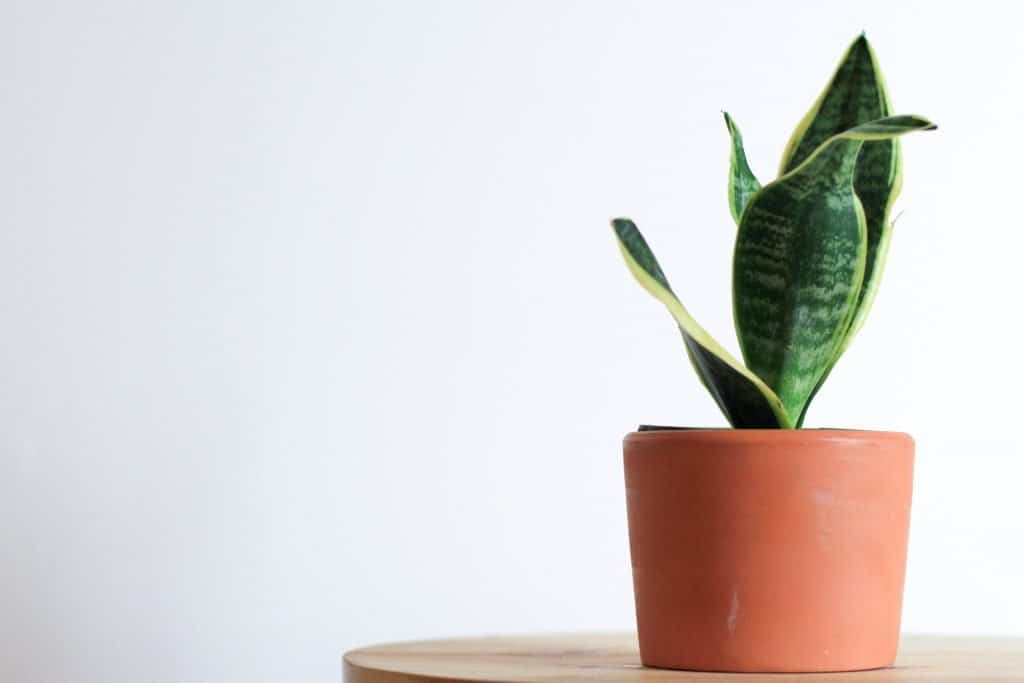
Houseplants aren’t only there for looks, they have fantastic air-purifying qualities and with pollution levels constantly rising, they’re becoming essential to a clean environment.
These plants will help decrease your stress levels by purifying the air and removing toxins to help you feel relaxed and have more energy throughout the day.
We’ve put together what we consider the 10 best air purifying and toxin removing indoor plants, with help from the NASA Clean Air Study to give you the information you need.
So here’s what we deduced, along with a rating on the overall score.
Peace Lily (Spathiphyllum) – Easiest To Maintain
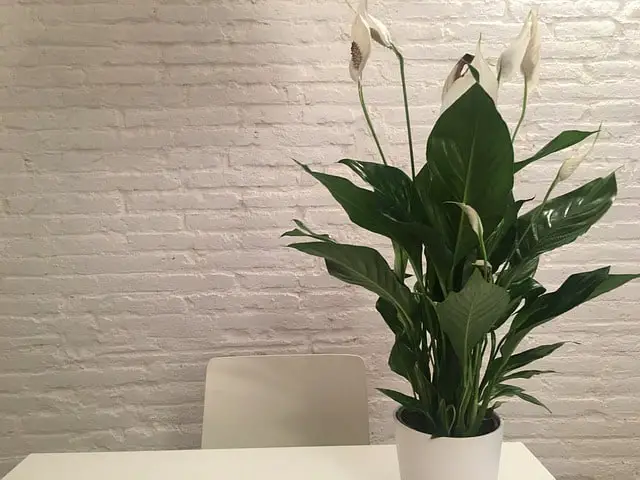
Overall Score:
Pros
- Removes Benzene
- Removes Trichloroethylene
- Removes Formaldehyde
- Removes Xylene & Toulene
- Removes Ammonia
- Easy To Maintain
Cons
- Toxic to Pets
Peace lilies are one of the most low maintenance plants so they are ideal for someone who’s time strained.
Peace lilies remove formaldehyde, benzene and tricholorethylene and keep your home full of fresh oxygen.
They are tropical, evergreen plants and require little maintenance, they can fit into any busy schedule.
To keep them maintained you just need to ensure that you water them at least once a week.
They’re pretty adaptable as far as plants go and they’re happy to sit in most places within a home.
Ideally you want them situated in an area with relatively low lighting.
Low light, not no light!
If your Peace Lily isn’t flowering then it’s likely you’ve put it somewhere a little too dark. Just move it closer to some light to help inspire some flowering.
English Ivy (Hedera Helix) – Wall Climber
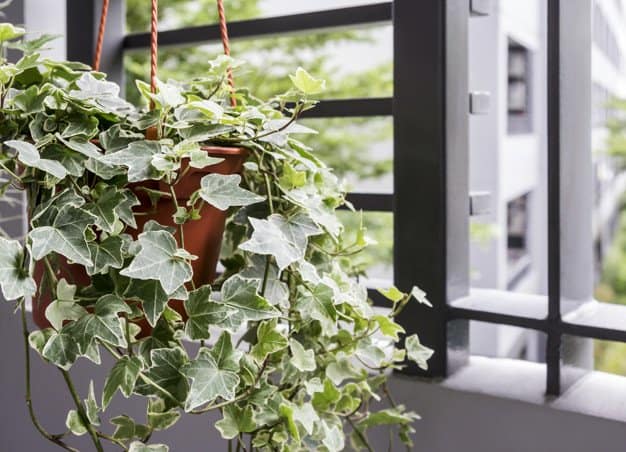
Overall Score:
Pros
- Removes Benzene
- Removes Trichloroethylene
- Removes Formaldehyde
- Removes Xylene & Toulene
- Wall Climber
Cons
- Toxic
It’s capable of climbing walls, so be aware of this when positioning the plant otherwise you might find it on your roof one day!
English Ivy is rated as one of the best by the NASA Clean Air Study, and to bolster its reputation further it’s easy to care for.
This plant is also known as a climber, so if you’re wanting it to grow up one of your interior walls then it can add an authentic natural feeling to any environment.
The plant itself tolerates a wide variety of environments, with it being native to most of Europe.
Keep it in a brightly lit area with filtered light, it doesn’t do too well in direct sunlight but will tolerate it.
Lower light generally allows the plant to have more colorful leaves.
Water this plant regularly to ensure that its soil is moist, it might require more regular watering if it begins growing quick.
Spray the Leaves
Doing this weekly will help avoid insects infesting the plant, mainly spider mites.
Barberton Daisy (Gerbera Jamesonii) – Pet Friendly
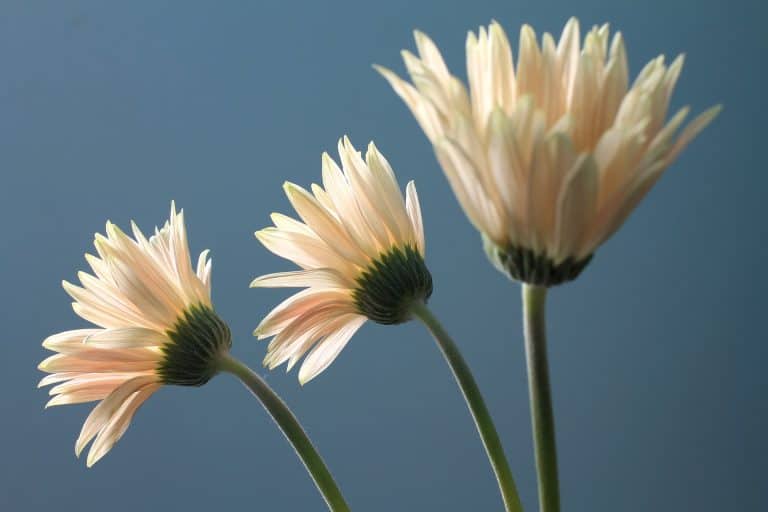
Overall Score:
Pros
- Removes Benzene
- Removes Trichloroethylene
- Removes Formaldehyde
- Easy To Care For
- Colourful
- Pet Friendly
Cons
- Requires Direct Sunlight
Barberton (Gerbera) daisies are non-toxic to dogs and cats, so they’re ideal if you have a furry friend in your home.
They’re one of the more colourful plants and will add a nice touch of color to your home.
You can usually find them in red, pink, yellow, white or orange.
They take formaldehyde, benzene and trichloroethylene out of your air and are easy to care for.
Keeping them healthy requires you to keep the soil moist at all times, watering it every few days should suffice.
Daisies are lovers of light, you need to keep them near windows that get plenty of natural sunlight for them to thrive.
Foliage
The leaves are beautiful, but they’re very fragile! It’s best to keep these out of reach of the little ones, or you might find all the leaves missing one day!
Snake Plant (Sansevieria Trifasciata) – High Oxygen Production
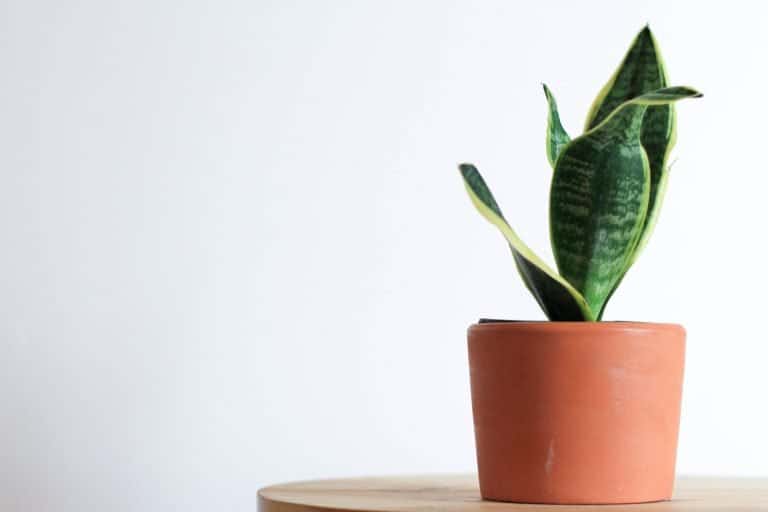
Overall Score:
Pros
- Removes Benzene
- Removes Trichloroethylene
- Removes Formaldehyde
- Removes Xylene & Toulene
- Simple To Care For
Cons
- Toxic to Pets
Snake plants are one of the most proficient in oxygen production, often people opt to have them in their bedrooms to promote a good nights sleep.
Snake plants are classed as a succulent plant and have remarkable abilities to remove a lot from the air, including formaldehyde, benzene, trichloroethylene, xylene and toluene.
They’re famous for their night-time oxygen production making them one of the best bedroom plants.
It’s native to tropical Africa but has been spread to many countries by people.
As it’s a succulent, it stores water in its leaves so you don’t need to water it too often, usually around once per month.
They’re happy in any light, but ideally, they prefer a balance of bright light, a little natural sunlight and some shade throughout the day.
When you’re handling the plant, it’s worth wearing gloves just in case it causes some irritation to your skin.
The main downside to this plant is that it’s toxic to pets, however, it’s not highly toxic but it will most likely make your beloved pet have diarrhoea, stomach ache or some vomiting.
Perfect Gift for Mother in Laws
An interesting fact about this plant is that it’s also known as “Mother In Law’s Tongue” – perhaps a testament to their durability!
Devil’s Ivy (Epipremnum aureum) – Hard to Kill
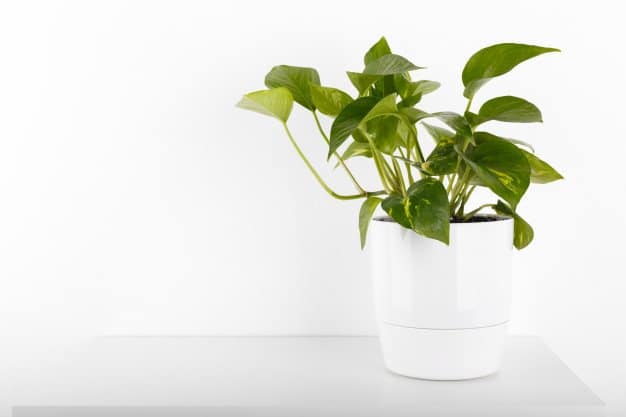
Overall Score:
Pros
- Removes Benzene
- Removes Formaldehyde
- Removes Xylene & Toulene
- Hard to Kill
Cons
- Toxic to Pets
- Toxic to Humans
These plants get their name from being notoriously hard to kill, even the most absent-minded owners will struggle to kill this one-off.
Devil’s ivy removes formaldehyde, benzene but they are toxic to cats, dogs and humans, unfortunately.
If you have small children, it’s best to avoid this plant for now as every part of them is toxic to humans and animals.
Maintaining the plant is easy, you only need to water it when the soil is dry to the touch but even if you forget for a while, it’s unlikely to die.
Ideally, it needs to be situated in a darker area, it’s even been known to survive in total darkness yet still have green leaves.
Too much light will cause the leaves to burn and the marbled effect will be lost.
It’s unlikely that the plant will start to flower, but if it’s getting larger than you’d like then just cut away the bits you don’t want.
Dry Brown Leaves
If you’re starting to notice these on the plant then try to increase the humidity within your room or move them to an area with more moisture in the air
Rubber Plant (Ficus Elastica) – Tall & Attractive
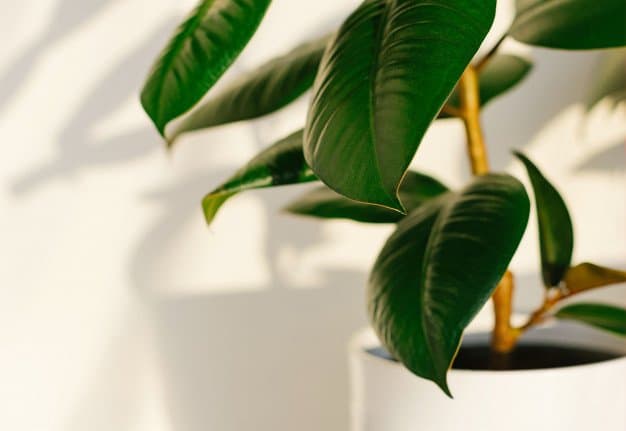
Overall Score:
Pros
- Removes Formaldehyde
- Tall Floor Plant
- Easy Maintenance
Cons
- Toxic to Pets
- Attracts Pests
In their natural environment, rubber plants are known to grow to over 30 metres tall but they’re easily managed so you can keep them at the height you desire with minimal effort.
Rubber plants are attractive but they’re on the lower end in terms of air purification as they only remove formaldehyde.
If you’re looking for a floor-based plant to grow to a substantial height then this is ideal.
It’s an easy plant to maintain, just water it a little once the soil is dry to the touch.
One of the most common mistakes growers make with this plant is over-watering it.
It will thrive in a well-lit area, just ensure that you keep it out of direct sunlight, but it will still manage in a low light area.
Keeping The Shine
The leaves on this plant are naturally glossy, but they can become slightly more matte if you don’t care for it properly. Simply wipe the leaves down with a soft cloth that’s been dipped in lukewarm water.
Aloe Vera – Health & Beauty Benefits
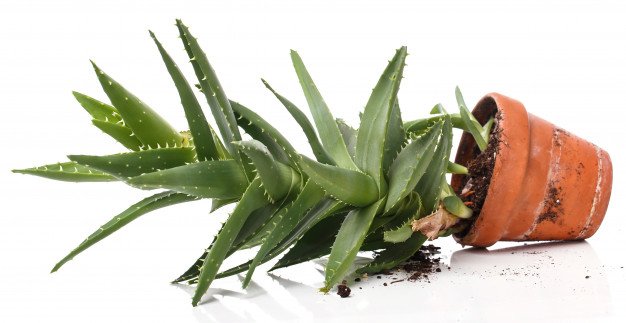
Overall Score:
Pros
- Removes Benzene
- Removes Formaldehyde
- Succulent
- Soothes Burns
Cons
- Toxic to Pets
It’s commonly used in beauty and health products, with many people shouting praise for its benefits, but there’s little scientific evidence supporting this.
It’s a common household plant due to it being so easy to care for and they belong to the succulent family.
To keep this plant healthy, ensure that the soil is always damp to the touch and is in a bright area, but not direct sunlight.
They clean the air from formaldehyde and benzene giving you a cleaner home environment.
It’s often kept in kitchens as it’s great for soothing burns, but should you feel any irritation doing this then stop immediately.
This is another plant that is proficient in producing nighttime oxygen, as you sleep it will take the carbon dioxide you’re producing out of the air and convert it into oxygen.
Mushy Leaves
If you find that the leaves are feeling soft and mushy, it’s likely that you are overwatering it. Cut down on how often you water the aloe vera plant and monitor its health.
Spider Plant (Chlorophytum Comosum) – Minimal Care
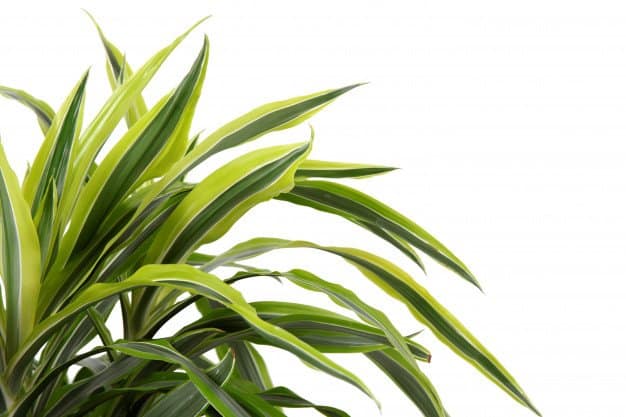
Overall Score:
Pros
- Removes Formaldehyde
- Removes Xylene & Toulene
- Ideal Beginner Plant
- Pet Friendly
Cons
- Can Look Messy
They’re one of the easiest plants to care for, they can survive on little water and light. However, without proper care, the leaves will begin to look messy or begin to brown.
Spider plants remove formaldehyde, xylene and toluene and are safe for pets.
They require minimal care but without appropriate care, the leaves will begin to look messy, it requires you to trim them back every few months to keep on top of it.
Situating it in a room with natural light but not too much will be ideal, most rooms will be fine as long as you keep it out of direct sunlight.
They’re one of the more thirsty plants so you’ll need to water it regularly, once a week should be enough to keep it happy but check that the soil is moist every few days.
It can survive in temperatures as low as 7 degrees Celsius so if you’re not one to keep the heating on in winter this is ideal for you.
Due to the way they grow, these plants look best in hanging baskets as the leaves will have more freedom to grow, looping over the basket.
Why Spider?
Spider plants grow plantlets from the main bush, giving them their unique “spidery” look.
Weeping Fig (Ficus Benjamina) – Slow Growing
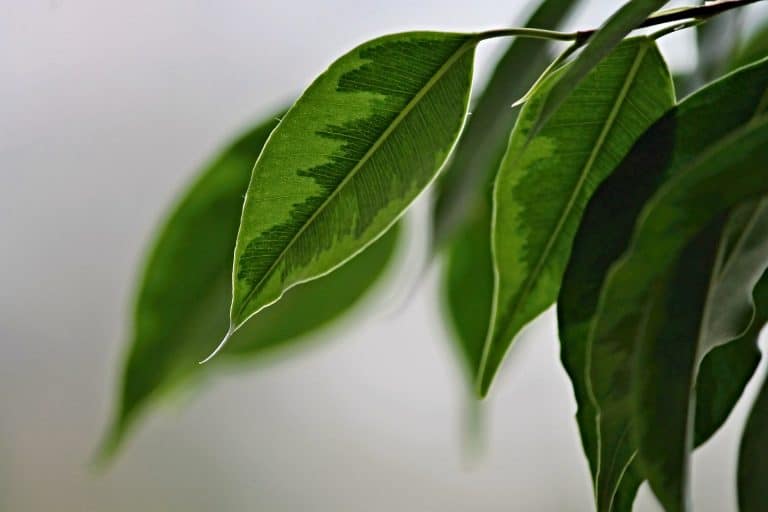
Overall Score:
Pros
- Removes Formaldehyde
- Removes Xylene & Toulene
- Tall Floor Plant
- Slow Growing
Cons
- Toxic to Pets
- Sensitive
They require a little more maintenance than other air purifying plants but you’ll be blessed with its qualities for many years with the right care.
Weeping figs take formaldehyde, xylene and toluene out of the air.
They’re sensitive plants, if they move location they are known to lose their leaves as they are easily shocked.
You want to ensure that the plant is situated in an environment that will not fluctuate massively in temperature.
To keep it healthy you need to use filtered, lukewarm water to ensure that you don’t shock the plant.
Water it once the topsoil has dried up, both too much and too little water can cause the plant to lose its leaves.
To flourish, it needs to be sat in bright light but also have some shade.
Slow Grow
One of the main reasons this plant is so popular, apart from its beautiful looks, is the fact that it grows slowly.
Broadleaf Lady Palm (Rhapis Excelsa) – Ammonia Reducing
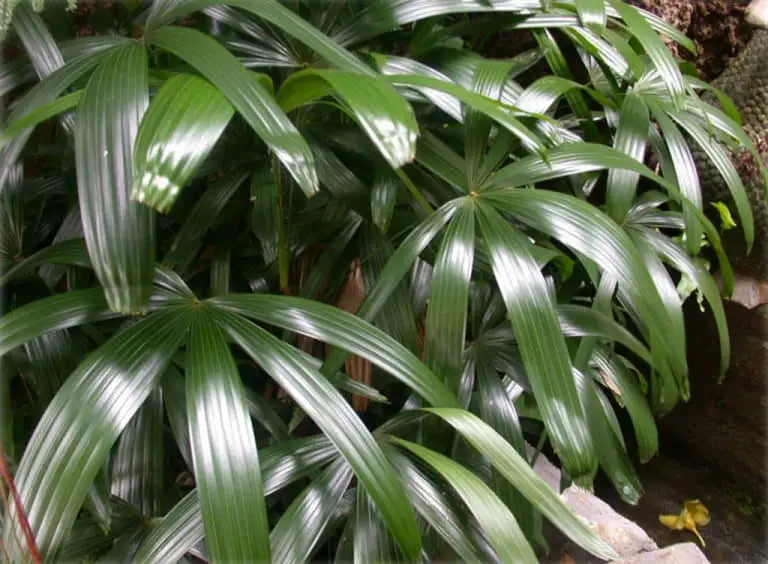
Overall Score:
Pros
- Removes Ammonia
- Removes Formaldehyde
- Removes Xylene & Toulene
- Non-Toxic
- Easy Care
Cons
- Needs Pruning
This is one of the few plants that are effective at removing ammonia from the air.
Broadleaf Lady Palms are very good at cleaning the air, they take out formaldehyde, carbon dioxide, xylene and the notoriously difficult ammonia.
Another easy plant to look after, it’s ideal for newbies to get stuck into some indoor home gardening.
This plant can tolerate a huge range of temperatures (-6 to 37°C) so it’s unlikely you’ll have any problems here.
Keep it out of direct sunlight as this will burn the leaves, it prefers to be sat in indirect sunlight to truly flourish.
To keep this plant healthy you need to ensure that the soil is always moist, but don’t water it too much as it will cause the roots to rot.
Dead Shoots
If any of the new shoots die off they must immediately be taken out of the soil to ensure that the rest of the plant stays healthy. Leaving dead shoots in will cause the rest of the plant to die off.

5 Houseplants Perfect for the First-Time Plant Parent - The Texas Tasty
Monday 20th of November 2023
[…] It’s still important to put some effort in, of course; without proper care, their leaves can turn brown and look messy. With proper care, they can live for 50 or more years! For more information, click […]
GanceAsd
Sunday 13th of June 2021
cialis generic online johannesburg [url=https://cialisjla.com/ ]find cialis online[/url] cocaine cialis
coellAni
Thursday 10th of June 2021
online pharmacy technician schools [url=https://pharmacyken.com/ ]actavis promethazine codeine online pharmacy[/url] best rogue online pharmacy
HeleSwa
Thursday 10th of June 2021
cialis generic cipla [url=https://ckacialis.com/ ]buy cialis pay pal[/url] how to buy cialis us
coellGtv
Wednesday 9th of June 2021
kmart pharmacy store hours [url=https://pharmacyhrn.com/ ]universities in canada pharmacy[/url] online pharmacy program